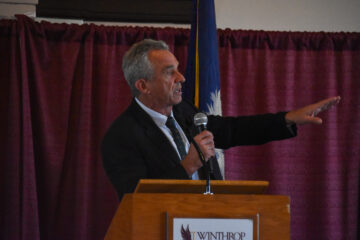The rise of religious “nones” signifies the decline of religious affiliates in the United States and sparks interest in what is at the heart of this change.
Religious affiliation continues to decline in the U.S. as the number of religious “nones” increases.
Religious “nones” are individuals with no religious affiliation, and their numbers in the United States have been increasing since 2009, according to a 2019 survey from the Pew Research Center. The percentage of religious “nones” in the United States rose from 17 percent in 2009 to 26 percent in 2019.
The global percentage of religious “nones” stands at 16 percent, but that number is expected to fall to 13 percent in 2060 due to the expansion of other religious groups.
The upbringing of people and their interactions with certain religions is certainly a factor in this reasoning. Statistically, three–quarters of the religious “nones” population has been raised in Christian households. Because Christianity is the majority of the religious population, the restrictive impressions of certain people often turn them away from religion entirely when they are older.
However, the religious “nones” are also among the most knowledgeable of other world religions like Judaism, Islam and Hinduism. A Pew Research Center study shows that once a majority of these people became religiously unaffiliated, they familiarized themselves with other religions and cultures to fully explore spirituality.
In the time of the internet, with so much information easily accessible to anyone with a smartphone or a computer, being raised with certain ideals can easily be altered. As people begin to either explore their own religion or doubt their own beliefs, the internet allows them to be far more educated on the topic. Depending on whether research further strengthens their beliefs or shows them ideals they do not believe in, the internet certainly assists both resolutions.
The denial of certain people because of who they are remains an integral factor of the conversation between religious “nones” and religious affiliates.
Pew Research conducted a study where religious and non-religious people were asked whether or not homosexuals should be accepted in modern society. There was a 22% difference between the nonaffiliated and the affiliated, which exemplifies a major connotation of religion.
No matter if there are religious groups that don’t agree with the rejection of certain people, homophobia still exists. Because of the presence of homophobia, religious organizations will always carry that connotation in today’s culture.
If more churches and religious organizations were to contest homophobic or transphobic ideas, then this could lead to increases in the religiously affiliated demographic.
While the denial of the LGBTQ+ community is not an ideal shared among all religious affiliates, it is still present in subsections of religions.
Depending on how people practice their religion, religion can be a major factor in choosing a political party as well. With concerns over abortion or the separation of church and state, personal religious beliefs can affect a person’s political alignment.
There is nuance to the political spectrum, as people, no matter their religious background, will choose a political party that most aligns with what they want for the country.
However, statistics show that religious “nones” are more likely to lean left on political stances. With topics like abortion or the relationship between church and state, some Democratic beliefs fall outside the beliefs of certain religions. This results in most of those religiously unaffiliated aligning with the Democratic Party, and Republican beliefs more often than not align with religious affiliates.
Politics may not be the focal reason for a person’s religious decision, but the dynamic between politics and religion continues to exist.
The presence of religious “nones” is not new, nor does it inherently disprove the value of spirituality, but their growth does represent a major societal change in the United States.
Photo by Emma Crouch




